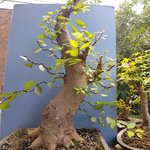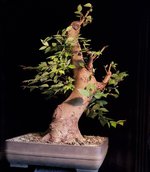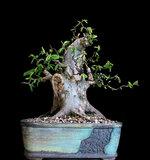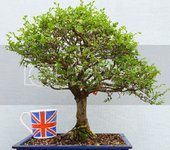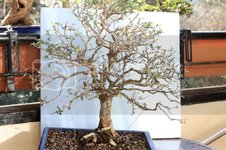You are using an out of date browser. It may not display this or other websites correctly.
You should upgrade or use an alternative browser.
You should upgrade or use an alternative browser.
Help styling zelkova
- Thread starter BuckeyeOne
- Start date
Eckhoffw
Masterpiece
Great question! Have often asked myself this.A few mentioned how the lower branches on this zelkova are smaller than the upper branches.
Should I allow them to grow out and thicken or remove? Cut back to buds?
View attachment 361926
IMHO I don’t know that you need those lower ones. I’d keep if I planned on chopping further down. But if not, I’d at least remove lower right one.
MrWunderful
Omono
Are you going for a broom, or informal upright?
BuckeyeOne
Chumono
At this point, I'm open to suggestions!
Lazylightningny
Masterpiece
If your plan is to use them, they need to be thicker. Let them run and thicken up while pruning the two thicker ones above them to hold them back. When they reach the desired thickness, cut them back. When new twigs grow, select one to be the new leader and cut off the rest. then let that one grow out. This will build taper in the branch. Then the next year you can begin to prune for ramification.
Nice piece of material.
Nice piece of material.
BobbyLane
Imperial Masterpiece
what trees have you been looking at for inspiration? something i often did when lost for ideas.
that vid helped me a lot too, people probably get sick of me sharing it. but it seems you dont understand the basics, so maybe it would benefit you.
that vid helped me a lot too, people probably get sick of me sharing it. but it seems you dont understand the basics, so maybe it would benefit you.
Last edited:
BobbyLane
Imperial Masterpiece
yeh you should allow the lower ones to grow out and thicken up a bit.A few mentioned how the lower branches on this zelkova are smaller than the upper branches.
Should I allow them to grow out and thicken or remove? Cut back to buds?
View attachment 361926
this is standard procedure on deciduous, you can find this approach on most of my progression threads. its basic stuff, Potter also touches on this.
i would only cut back the low ones now, IF they were so leggy that they only had buds at the tips, but thats not the case judging by your only pic.
so now you clean up the upper branches, cut out the crap not needed, you can understand which branches can be removed by watching the video. tidying it up is the first step... show us again once you did that....
Attachments
BobbyLane
Imperial Masterpiece
Heres an example of a chinese elm being tidied up after purchase by following some of the steps in above video...
here it is again after a hard cut back a couple years in
here it is again after a hard cut back a couple years in
Attachments
BuckeyeOne
Chumono
@BobbyLane Thanks for the advice.
The tree is just coming off a season of being compromised, so I'm just waiting to see what it produces in terms of new growth this year, buds are just beginning to appear on a few of the tips.
There are not a lot of apparent buds on the two lower branches with the exception of the ends. I'll wait a few weeks to see if more appear before selecting where to trim back to.
The upper canopy actually was great ramification, but needs a major cleanup. Reducing the larger branches is a definite need.
A couple more pictures.


The tree is just coming off a season of being compromised, so I'm just waiting to see what it produces in terms of new growth this year, buds are just beginning to appear on a few of the tips.
There are not a lot of apparent buds on the two lower branches with the exception of the ends. I'll wait a few weeks to see if more appear before selecting where to trim back to.
The upper canopy actually was great ramification, but needs a major cleanup. Reducing the larger branches is a definite need.
A couple more pictures.


luvinthemountains
Chumono
Ha, now that I look at my markups it looks like I was trying to draw an abstract dancing figure. Anyhow, on to my points...
The position and profile of your first branch looks good. As others have said, just grow that out and it will thicken.
The second branch, though, comes from inside a bend, which I have tried to outline to make it more clear. I feel that creates an uncomfortable instability in the design.
Next, your third and fourth side branches look like bar branches, and have the unfortunate visual effect of making a "swoosh." If removing one, I would probably keep the left one, which comes from the trunk at a better angle.
Lastly, the thick extension of the upper branch I have circled is overly strong, and should be removed. (Not that you asked.)
Note that I normally suck at design, though I am trying to get better. So take my comments for what they are worth.

The position and profile of your first branch looks good. As others have said, just grow that out and it will thicken.
The second branch, though, comes from inside a bend, which I have tried to outline to make it more clear. I feel that creates an uncomfortable instability in the design.
Next, your third and fourth side branches look like bar branches, and have the unfortunate visual effect of making a "swoosh." If removing one, I would probably keep the left one, which comes from the trunk at a better angle.
Lastly, the thick extension of the upper branch I have circled is overly strong, and should be removed. (Not that you asked.)
Note that I normally suck at design, though I am trying to get better. So take my comments for what they are worth.

BobbyLane
Imperial Masterpiece
Ha, now that I look at my markups it looks like I was trying to draw an abstract dancing figure. Anyhow, on to my points...
The position and profile of your first branch looks good. As others have said, just grow that out and it will thicken.
The second branch, though, comes from inside a bend, which I have tried to outline to make it more clear. I feel that creates an uncomfortable instability in the design.
Next, your third and fourth side branches look like bar branches, and have the unfortunate visual effect of making a "swoosh." If removing one, I would probably keep the left one, which comes from the trunk at a better angle.
Lastly, the thick extension of the upper branch I have circled is overly strong, and should be removed. (Not that you asked.)
Note that I normally suck at design, though I am trying to get better. So take my comments for what they are worth.
View attachment 361975
thats nots a design though its more of a diagram so youre fine lol
Note that one of the major branches on my zelkova also comes from a curve. doesnt affect the image though. its one of those 'guidelines' that can be ignored as it 'depends'. sometimes it works other times maybe not. its the same with bar branches. sometimes they can be forgiven, other times they stick out like a sore thumb.
i think the OP needs to put some research work in and begin thinking for himself tbh
BobbyLane
Imperial Masterpiece
ok then, it sort of seemed like you started another thread to ask for styling advice. ill leave you to it then@BobbyLane Thanks for the advice.
The tree is just coming off a season of being compromised, so I'm just waiting to see what it produces in terms of new growth this year, buds are just beginning to appear on a few of the tips.
There are not a lot of apparent buds on the two lower branches with the exception of the ends. I'll wait a few weeks to see if more appear before selecting where to trim back to.
The upper canopy actually was great ramification, but needs a major cleanup. Reducing the larger branches is a definite need.
A couple more pictures.
View attachment 361972View attachment 361974
MrWunderful
Omono
Well the problem is, the branching doesn’t really work for either of those styles. You may be able to get a natural style out of it, but sometimes That can be a cop out. That’s why in the other thread I recommended that you cut all the branches off and start from scratch.At this point, I'm open to suggestions!
You can let the lower branches grow out but they probably should get some movement in them because they are stick straight with long internodes.
But the best suggestion is to decide what style you would like, and research inspiration from there. Just pruning without a plan in the future in mind is how the tree looks the way it does now, somebody just came and hedge trimmed the top repeatedly.
BobbyLane
Imperial Masterpiece
the branching works for an image like this



 ibonsaiclub.forumotion.com
ibonsaiclub.forumotion.com
i can pull up ideas like this almost instantly, this is because over the years ive took time out to research what others have done.



Which Broom - A Chinese Elm one
Here's the 2010 update of my Chinese Elm broom in a pot by Nick Lenz. First a hasty shot showing how the roots have pushed the soil out of the pot. Look at the
i can pull up ideas like this almost instantly, this is because over the years ive took time out to research what others have done.
leatherback
The Treedeemer
As I see it the branches lack taper and movement as well which is hard to fix, but Zelkova are really keen on being ground layered I’ve found! So you could lose the lower two and get two shorter, stockier trees. But still the upper part has future problems brewing, so maybe use the branch layout to your advantage to create a raft and “ground” layer off the top and branches down the left side, the base will survive too and send sucker/shoots up through the soil. That way you get a stocky chopped base to work with, a few small trees that were the left branches and the main air layer/right side to lay flat and start the process to turn into a raft?
Here’s one I “ground” (tall pot) layered earlier. Note the sucker from the lower part (the one on the right)!

Here’s one I “ground” (tall pot) layered earlier. Note the sucker from the lower part (the one on the right)!

Last edited:
BuckeyeOne
Chumono
I did but got a little impatient!! Sorry. I spent more than a couple pesos on this one and hoping it develops to a garden highpoint!.started another thread
I'm sure I'll be back for more advice as this one progresses!!!
I'll update as I go!
BobbyLane
Imperial Masterpiece
Tip 1, they only develop when you work on them

Leatherback offered a good first step as have others!
Leatherback offered a good first step as have others!
Leo in N E Illinois
The Professor
- Messages
- 11,636
- Reaction score
- 24,380
- USDA Zone
- 5b
@BuckeyeOne
This is a nice enough start of a tree that it has caught the eye of @BobbyLane and a few others, including myself. @BobbyLane - I just re-watched the Graham Potter video you linked and thought it pretty good. I could see no flaws in his advice. I heartily recommend watching many of the Graham Potter videos. The quality of his information is quite good. He is "not Ryan Neil" which is actually a compliment. We need to walk before we run.
Note, I did not find the other thread on this tree, so I don't know what @leatherback suggested.
About the "Rules" that you might think Bobby Lane was dismissing as optional. The rules can be extremely helpful if you are not certain what to do. When choosing which branch to keep, which to eliminate, the rules can really help. Bobby is absolutely correct that they are at best "guides" and not hard and fast rules, but ignoring the rules, with out having an artistic reason to ignore the rules often results in an inferior tree. There are a couple old timers on this forum, when you look at their 30 years in training trees, and you don't feel "captivated" often with close examination you can see poorly constructed nebari, branches with excessively long internodes in areas where the internodes should have been getting progressively shorter, thick branches high in the tree, branches from inside of curves, bar branches, and internodes longer than the distance from the soil line to the first branch on the trunk. These "rules" can be broken if artistic design requires it, but if broken haphazardly, with no real purpose, or if ignored entirely, you end up with that tree that makes one wonder; "Wow, they put 30 years or more into developing this thing, and it looks, uninteresting".
So I consider the advice from @luvinthemountains to be good advice. Its not a "style" or a "design" but it is eliminating a few problems. Bobby Lane is correct, the "rules" are optional, but ignore them at your peril. If you don't have an artistic necessity for ignoring the rule, there is the danger the ignored branch from an inside curve, or the odd, out of place long internode, or the bar branch, will in time continue to distract from the image you are trying to create.
Zelkova are not rare, stock is not overly expensive and it develops quickly. Air layering for propagation sake is not really needed. Air layering to get a better nebari may be essential. Air layering can also shorten the distance from the roots to the first branch. I'm not sure I like the nebari that is visible in this tree, you need to decide if it is "good enough" for your design.
You need to decide what design you would like. As a mental exercise, consider removing absolutely every branch, what line is your main trunk? Do you want the main trunk to divide into sub-trunks, as in the style of an informal broom? The informal broom the trunk divides from 1 to 2 sub-trunks, then the 2 divide to 4 sub-trunks, then the branches develop from there with no "bright distinction" between sub-trunks and main branches. The pattern is 1, 2, 4, 8, 16, 32 and so on for ramification. Or do you want a more "traditional informal upright" in that there is a single trunk line, and branches all the way up to the apex? As Bobby Lane suggested, it is your tree, you need to choose.
You are in zone 6a. Probably northern Ohio or eastern Michigan or western New York state. This tree should be dormant if it was being stored outside. You have a month before it should wake up. You have time to sit with a pad of paper and draw out possible designs. Or sit with a photo and a photo editor program. Create a design. Use the trunk and branches you ACTUALLY have. Find the trunk line you like. Consider chopping back drastically. Think about where branches would pop if you cut back to a SINGLE trunk line. Consider how long, what length that single trunk line should be.
Consider the alternate, keeping as much as possible. Consider what the tree would look like 5 years down the road if you kept everything possible.
Then consider various "intermediate" approaches. Then you choose what appeals to you. You have time. Take the time to design this tree to your tastes. Even if you don't come up with a design in the 3 or 4 weeks before growth begins, you can always let it grow a while before beginning the execution of a design. You can even leave it grow a year or two until you have a design. But be deliberate in the direction you choose to go. Make a decision, then stick with it at least long enough to see the effect it has on the tree.
This is a nice enough start of a tree that it has caught the eye of @BobbyLane and a few others, including myself. @BobbyLane - I just re-watched the Graham Potter video you linked and thought it pretty good. I could see no flaws in his advice. I heartily recommend watching many of the Graham Potter videos. The quality of his information is quite good. He is "not Ryan Neil" which is actually a compliment. We need to walk before we run.
Note, I did not find the other thread on this tree, so I don't know what @leatherback suggested.
About the "Rules" that you might think Bobby Lane was dismissing as optional. The rules can be extremely helpful if you are not certain what to do. When choosing which branch to keep, which to eliminate, the rules can really help. Bobby is absolutely correct that they are at best "guides" and not hard and fast rules, but ignoring the rules, with out having an artistic reason to ignore the rules often results in an inferior tree. There are a couple old timers on this forum, when you look at their 30 years in training trees, and you don't feel "captivated" often with close examination you can see poorly constructed nebari, branches with excessively long internodes in areas where the internodes should have been getting progressively shorter, thick branches high in the tree, branches from inside of curves, bar branches, and internodes longer than the distance from the soil line to the first branch on the trunk. These "rules" can be broken if artistic design requires it, but if broken haphazardly, with no real purpose, or if ignored entirely, you end up with that tree that makes one wonder; "Wow, they put 30 years or more into developing this thing, and it looks, uninteresting".
So I consider the advice from @luvinthemountains to be good advice. Its not a "style" or a "design" but it is eliminating a few problems. Bobby Lane is correct, the "rules" are optional, but ignore them at your peril. If you don't have an artistic necessity for ignoring the rule, there is the danger the ignored branch from an inside curve, or the odd, out of place long internode, or the bar branch, will in time continue to distract from the image you are trying to create.
Zelkova are not rare, stock is not overly expensive and it develops quickly. Air layering for propagation sake is not really needed. Air layering to get a better nebari may be essential. Air layering can also shorten the distance from the roots to the first branch. I'm not sure I like the nebari that is visible in this tree, you need to decide if it is "good enough" for your design.
You need to decide what design you would like. As a mental exercise, consider removing absolutely every branch, what line is your main trunk? Do you want the main trunk to divide into sub-trunks, as in the style of an informal broom? The informal broom the trunk divides from 1 to 2 sub-trunks, then the 2 divide to 4 sub-trunks, then the branches develop from there with no "bright distinction" between sub-trunks and main branches. The pattern is 1, 2, 4, 8, 16, 32 and so on for ramification. Or do you want a more "traditional informal upright" in that there is a single trunk line, and branches all the way up to the apex? As Bobby Lane suggested, it is your tree, you need to choose.
You are in zone 6a. Probably northern Ohio or eastern Michigan or western New York state. This tree should be dormant if it was being stored outside. You have a month before it should wake up. You have time to sit with a pad of paper and draw out possible designs. Or sit with a photo and a photo editor program. Create a design. Use the trunk and branches you ACTUALLY have. Find the trunk line you like. Consider chopping back drastically. Think about where branches would pop if you cut back to a SINGLE trunk line. Consider how long, what length that single trunk line should be.
Consider the alternate, keeping as much as possible. Consider what the tree would look like 5 years down the road if you kept everything possible.
Then consider various "intermediate" approaches. Then you choose what appeals to you. You have time. Take the time to design this tree to your tastes. Even if you don't come up with a design in the 3 or 4 weeks before growth begins, you can always let it grow a while before beginning the execution of a design. You can even leave it grow a year or two until you have a design. But be deliberate in the direction you choose to go. Make a decision, then stick with it at least long enough to see the effect it has on the tree.
BuckeyeOne
Chumono
@Leo in N E Illinois Thank you! Yes, I am just west of Cleveland.
I have not discounted the advice of @BobbyLane . I have actually taken it to heart as I value his opinion as well as yours.
I just did not want to start down a road with no turning back, once started!
Grahams video is very well presented and informative. I've watched it several times in the past and will revisit.
I am very aware of several major flaws in the tree. A possible bar branching when viewed from a specific angle, weak lower branching, strong apex branching and so on.
The tree was stored in a cold frame until 2 weeks ago, were It was moved into my attached garage. It suffered a very stressful season last year and had lost majority of foliage well before fall, so I wasn't sure it would even survive! It is just beginning to show signs of life by producing small buds on some branches. I will monitor going forward to see what is viable growth, then decide what can be removed due to dieback and what is keepable.
Again, Thank you all for your advice!!
I have not discounted the advice of @BobbyLane . I have actually taken it to heart as I value his opinion as well as yours.
I just did not want to start down a road with no turning back, once started!
Grahams video is very well presented and informative. I've watched it several times in the past and will revisit.
I am very aware of several major flaws in the tree. A possible bar branching when viewed from a specific angle, weak lower branching, strong apex branching and so on.
The tree was stored in a cold frame until 2 weeks ago, were It was moved into my attached garage. It suffered a very stressful season last year and had lost majority of foliage well before fall, so I wasn't sure it would even survive! It is just beginning to show signs of life by producing small buds on some branches. I will monitor going forward to see what is viable growth, then decide what can be removed due to dieback and what is keepable.
Again, Thank you all for your advice!!
Similar threads
- Replies
- 9
- Views
- 1K


